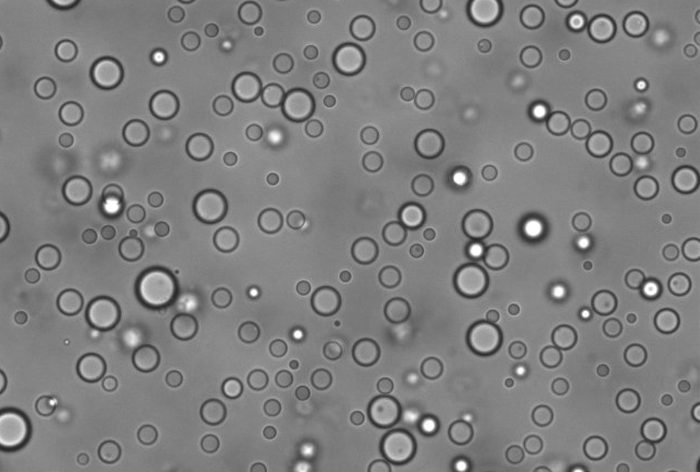BUFFALO, N.Y. — Liquid droplets of protein and RNA have traits reminiscent of a childhood joy: Silly Putty.

Credit: Credit: Ibraheem Alshareedah / Banerjee Lab
BUFFALO, N.Y. — Liquid droplets of protein and RNA have traits reminiscent of a childhood joy: Silly Putty.
That’s according to a study by scientists at the University at Buffalo and Iowa State University, who have created such droplets in the lab and used tools including laser tweezers to measure the materials’ properties.
The work could have implications for cell biology, as the lab-made droplets resemble membraneless organelles (MLOs) that are found in cells and that are also made from protein and RNA, says Priya Banerjee, PhD, assistant professor of physics in the UB College of Arts and Sciences.
“In order to understand the biological functions of MLOs, which can play a role in diseases such as neurodegeneration and cancer, we need to learn more about their properties,” Banerjee says. “What type of material are we dealing with?
“The model protein-RNA condensates we created in the lab exhibit material properties of a viscoelastic Maxwell fluid, with behaviors similar to commonly available Silly Putty. These condensates can be solid- or liquid-like, depending on the timescale. At a shorter timescale, they behave like elastic solids, but they are viscous and have liquid-like properties such as flow and internal mobility at longer timescales.”
Given the duality of both viscous liquid-like and elastic solid-like behavior in these materials, they are called viscoelastic fluids, Banerjee notes.
The research was published on Nov. 16 in Nature Communications.
Banerjee led the study with UB physics PhD student Ibraheem Alshareedah and Iowa State University Assistant Professor of Chemistry Davit Potoyan, PhD. Co-authors included UB physics postdoctoral researcher Mahdi Muhammad Moosa and Iowa State physics undergraduate researcher Matthew Pham, who is now a PhD student at the University of Chicago.
Simple design rules control droplets’ viscoelasticity
As part of the study, scientists were able to identify simple design rules for controlling the viscoelasticity of the droplets they created.
As Banerjee explains, proteins are made from building blocks called amino acids, and some of these amino acids are “sticky,” meaning that they tend to attract each other and RNA. The researchers found that sticky building blocks promote elasticity in the droplets, while non-sticky building blocks promote the liquid-like behavior.
“It may seem like a small change to replace just a single amino acid in the entire peptide sequence. Yet, our computer simulations show that some amino acids are way ‘stickier’ when it comes to binding to RNA molecules. This differential stickiness at microscopic scales then propagates to create large-scale changes in the fluid properties of condensates. That’s the main story of this research,” Potoyan says.
“This is interesting because in some diseases, you see the material property of these droplets change in cells, so maybe they transform from a more fluid state to a more solid state,” says Alshareedah, the study’s first author. “This was the question that drove us to start focusing on developing experimental techniques to quantify the viscoelastic properties of these droplets.”
“The ability to quantify viscoelasticity of membrane-less organelles is exciting since we now can go after the important question of how genetic mutation and/or aging processes result in pathological transformation of these organelles. In the future, such understanding could catalyze translational research efforts to counteract the disease processes,” Banerjee says.
The research was funded in part by the National Institute of General Medical Sciences, part of the U.S. National Institutes of Health.
Journal
Nature Communications
DOI
10.1038/s41467-021-26733-7
Article Title
Programmable viscoelasticity in protein-RNA condensates with disordered sticker-spacer polypeptides
Article Publication Date
16-Nov-2021




